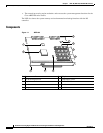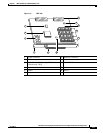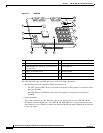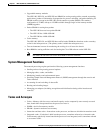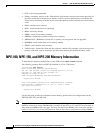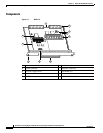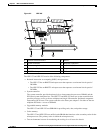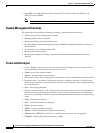
1-5
Network Processing Engine and Network Services Engine Installation and Configuration
OL-4448-12
Chapter 1 NPE-100, NPE-150, and NPE-200 Overview
NPE-100, NPE-150, and NPE-200 Description and Overview
• Upgradable memory modules
The NPE-100, NPE-150, and NPE-200 use DRAM for storing routing tables, network accounting
applications, packets of information in preparation for process switching, and packet buffering for
SRAM overflow (except in the NPE-100, which contains no packet SRAM). The standard
configuration is 32 MB, with up to 128 MB available through single in-line memory module
(SIMM) upgrades.
• Packet SRAM for storing data packets
–
The NPE-100 does not have packet SRAM.
–
The NPE-150 has 1 MB of SRAM.
–
The NPE-200 has 4 MB of SRAM.
• Cache memory
The NPE-100, NPE-150, and NPE-200 have unified cache SRAM that functions as the secondary
cache for the microprocessor. (The primary cache is within the microprocessor.)
• Two environmental sensors for monitoring the cooling air as it leaves the chassis
• Boot ROM for storing sufficient code for booting the Cisco IOS software on the NPE-200
Note The NPE-100 and NPE-150 use the boot ROM on the I/O controller.
System Management Functions
The network processing engines perform the following system management functions:
• Sending and receiving routing protocol updates
• Managing tables, caches, and buffers
• Monitoring interface and environmental status
• Providing Simple Network Management Protocol (SNMP) management through the console and
Telnet interface
• Accounting for and switching of data traffic
• Booting and reloading images
• Managing port adapters (including recognition and initialization during online insertion and
removal)
Terms and Acronyms
• Cache—Memory with fast access and small capacity used to temporarily store recently accessed
data; found either incorporated into the processor or near it.
• DIMM—dual in-line memory module
• DRAM—dynamic random-access memory
• Instruction and data cache—Instructions to the processor, and data on which the instructions work.
• Integrated cache—Cache that is built into the processor; sometimes referred to as internal cache.
Cache memory physically located outside the processor is not integrated, and is sometimes referred
to as external cache.








